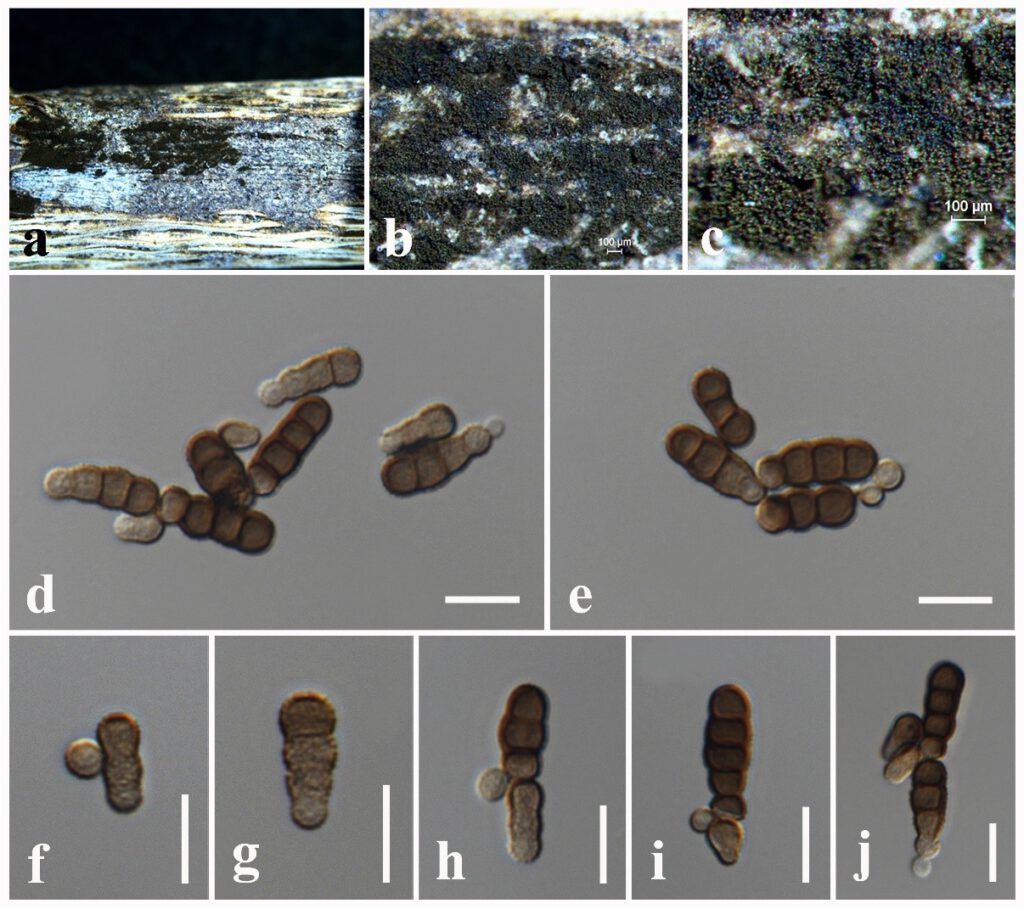Torula canangae N.I. de Silva, Lumyong & K.D. Hyde, sp. nov.
MycoBank number: MB; Index Fungorum number: IF; Facesoffungi number: FoF 10720; Fig. 6.39
Etymology: Name reflects the host genus Cananga, from which the new species was isolated.
Holotype: MFLU 21-0250
Saprobic on dead twigs attach to Cananga odorata. Sexual morph: Undetermined. Asexual morph: Hyphomycetous. Colonies effuse on host, black, powdery. Mycelium partly immersed to superficial on the substrate, composed of septate, branched, smooth, hyaline hyphae. Conidiophores indistinct. Conidiogenous cells 3–4 × 3.5–5 μm ( = 3.4 × 4.2 µm, n = 10), light brown, ellipsoid to coronal, polyblastic, terminal, smooth to minutely verruculose, thick-walled. Conidia 10–18 × 4–6 μm ( = 16 × 5 µm, n = 30), light brown to dark brown, subcylindrical, catenate, acrogenous, phragmosporous, smooth to distinctly verrucose, 2–4-septate, rounded at apex, slightly constricted at some septa.
Culture characteristics – Colonies on PDA reaching 30 mm diameter after 3 weeks at 25°C, colonies from above: white, circular, flat, slightly raised, fluffy appearance at the centre, cream at the margin; reverse: pale brown from the centre of the colony, white at margin.
Material examined – THAILAND, Chiang Rai Province, dead twigs attached to the host plant of Cananga odorata (Annonaceae), 2 January 2019, N. I. de Silva, CO1 (MFLU 21-0250, holotype), ex-type living culture, MFLUCC 21-0169.
Notes – Phylogeny based on combined LSU, SSU, tef1, rpb2 and ITS sequence data indicates that a new strain (MFLUCC 21-0169) which share similar morphological characteristics of Torula constitutes a strongly supported distinct lineage in a clade comprising T. chiangmaiensis, T. hollandica, T. pluriseptata, T. polyseptata and T. thailandica with 92% ML, 1.00 BYPP statistical support. The strain (MFLUCC 21-0169) has smaller conidia length (considering average conidial length) and lesser number of conidial septa than phylogenetically closely related T. chiangmaiensis, T. polyseptata and T. thailandica (Table 4). Considering morpho-molecular data, we conclude that Torula canangae is a novel species.

Figure 6.39 Torula canangae (MFLU 21-0250, holotype) a–c Appearance of colonies on substrate. d–j Conidia with conidiogenous cells. Scale bars: b, c = 100 μm, d–j = 10 μm.
